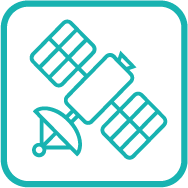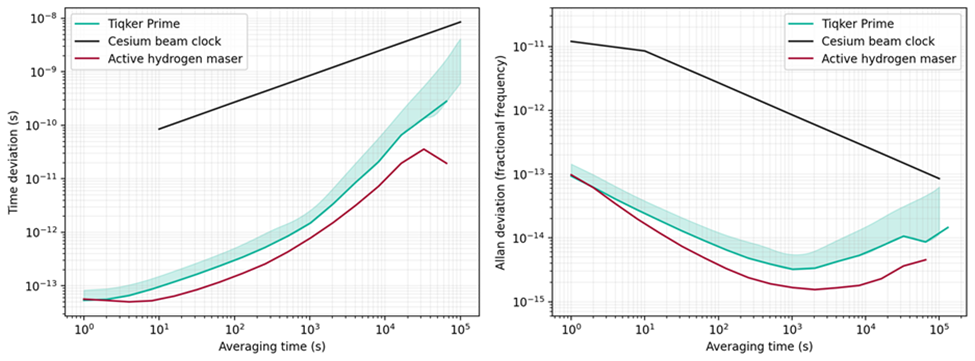Next-Generation Optical Atomic Clock for Critical Applications



Compact, rugged, and deployable for defense, space, and commercial missions. Tiqker offers active hydrogen maser short-term precision in a compact form-factor package that occupies the same rack space as cesium-beam frequency references.

High-Precision Optical Atomic Frequency Reference
- 10,000× higher atomic transition frequency than microwave clocks for superior precision and environmental stability.
- Hydrogen Maser-like short-term performance in a smaller, lighter, and more power-efficient package.
- Cs-beam-like holdover up to 7 days.
- 3U, 19-inch rack-mounted form factor.
Infleqtion is bringing this transformational technology out of the laboratory and into the world.


Key Advantages of Tiqker

Deployable
Active Hydrogen Maser performance in a rugged, transportable form factor.

Phased Array / Multi-Static Synchronization
Improved beam accuracy and directionality for over-the-horizon tracking, directional eavesdropping, and low probability of intercept data links.

Drone Defense
Low phase noise oscillator for next-generation radar detection, tracking, and fire control.

Assured PNT
On-board timescales for GPS-denied and GNSS-denial environments (crewed and UUV submarine).

Enhanced Space Operations
High bandwidth, multichannel connectivity (even without GPS) for better tracking and geolocation.

Autonomy
Synchronization and coordination across platforms and swarms.


AI-Ready Precision Timing and Resource Optimization
Precision Timing & Synchronization
Ensures AI workloads are processed with minimal latency and all data is consistently and accurately timestamped—critical for AI model coordination and real-time inference.
Efficient Resource Utilization
Optimizes resource allocation across compute clusters, helping data centers handle dynamic AI demands more efficiently while reducing risks of system overload.
Future‑Proofing for AI Growth
As AI scales, Tiqker serves as the foundational timekeeping technology, enhancing infrastructure efficiency and reliability to meet rising demand.

Proven in Field and Lab
- Demonstrated Hydrogen Maser frequency stability at 1 second and holdover outperforming Cesium Beam clocks past 1 day.
- 10× smaller than hydrogen masers, with ruggedization proven in PNTAX23 field trials, flight trials, and shock/vibration testing.
- Outperforms 5071, RAFS, CSAC, and similar compact technologies over short-to-mid timescales.
- Supports ~10 ps synchronization between disparate sites using White Rabbit timing.


Applications

Defense
- UAV detection and countermeasures
- C5ISR systems
- Electronic warfare
- Hypersonic missile tracking
- Radar beamforming and tracking (phased/multi-static)

Commercial
- Space asset tracking
- Data center timing resilience
- Precision geolocation
- Autonomous systems coordination

Designed for Rapid Innovation
Tiqker Prime Zero (Prototype)
Launched Q3 2023

Tiqker Prime (Pre-Production)
Launched Q1 2024

Tiqker Prime (Current Production)
Upgraded control system, cost-optimized manufacturing


Miniaturizing Precision with Silicon Photonics
Tiqker’s groundbreaking accuracy comes from precise laser and frequency comb systems. With photonic-integrated circuit (PIC)-based lasers and miniature PIC-based frequency combs, future Tiqker devices will shrink from rack-mounted systems to chip-scale modules. Integrated photonics enables rugged, low-cost clocks ideal for aerospace, defense, and commercial markets. A PIC-based Tiqker module will be utilized in other Infleqtion quantum systems for both timing and laser frequency control.

Learn the Latest in Tiqker Atomic Clocks
Podcast: Infleqtion CEO Matthew Kinsella | Room Temperature Neutral Atom Quantum Computing | Thinking on Paper
Tiqker Optical Atomic Clock: Pushing the Limits of Timing Technology
Panel: Quantum Sensing at Scale: Navigating Commercialization Roadblocks | Market Accel. | QWC 2025
Webinar: Quantum Technologies for National Resilience and Security
Webinar: Learn About Tiqker, A Cutting-Edge Atomic Clock
Conference Session: Enhanced Timekeeping with Optical Clocks | OCP Global Summit 2023
Panel: State of the Domain: Quantum Sensors | Quantum World Congress 2023
Podcast: Quantum Clocks, Sensing, and, of course, Computing― with Infleqtion | Ep. 56
Webinar: Tick Tock: Learn about Quantum Atomic Clocks! feat. Dr. Evan Salim
Infleqtion Secures $2M U.S. Army Contract to Advance Contextual Machine Learning for Assured Navigation and Timing
Read more
ITSF 2025 Retrospective
Read more
Infleqtion and Royal Navy Demonstrate World’s First Quantum Optical Clock on Underwater Autonomous Submarine to advance GPS-Free Navigation
Read more
Infleqtion Unveils 5-year Quantum Computing Roadmap, Advancing Plans to Commercialize Quantum at Scale
Read more
Infleqtion Raises $100M to Scale Atom-Based Quantum Solutions for National Security and Next Generation Intelligent Systems
Read more
Infleqtion Secures $11 Million DoD APFIT Award to Accelerate Deployment of Quantum Timing for Defense Applications
Read more
Infleqtion Marks Milestone with First UK Sale of Quantum Clock, Tiqker
Read more
Un-Jammable Quantum Tech Takes Flight to Boost UK’s Resilience Against Hostile Actors
Read more
Infleqtion’s Atomic Clock, Tiqker, Wins Platinum Military + Aerospace Electronics Innovators Award
Read more

Find More Tiqker Atomic Clock Resources




Get In Touch
Your path to quantum advantage starts here.
